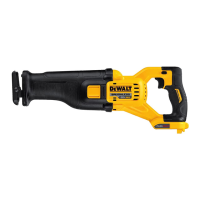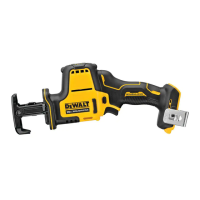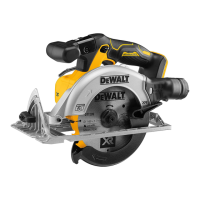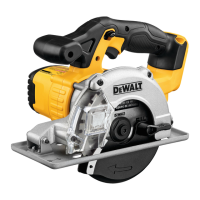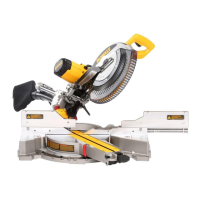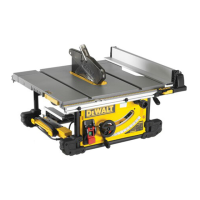14
ENGLISH
Changing Blades(Fig.A,E–G)
To Install the Blade
1. Place inner clamp washer
17
on saw spindle
19
with the
large flat surface facing out toward the blade(Fig.E,F).
2. Retract the lower blade guard
7
and place blade
20
on
saw spindle against the inner clamp washer
17
, making
sure that the blade will rotate in the proper direction(the
direction of the rotation arrow on the saw blade and the
teeth must point in the same direction as the direction of
rotation arrow on the saw).Do not assume that the printing
on the blade will always be facing you when properly
installed.When retracting the lower blade guard to install
the blade, check the condition and operation of the lower
blade guard to assure that it is working properly.Make sure
it moves freely and does not touch the blade or any other
part, in all angles and depths ofcut.
3. Place the outer clamp washer
18
on the saw spindle
19
with the large flat surface against the blade
20
with
beveled side facingout.
4. Thread the blade clamping screw
6
into the saw spindle
by hand.(Screw has left-hand threads and must be turned
counterclockwise to tighten.Refer to arrow in FigureGA.)
5. Depress the spindle lock button
4
while turning the saw
spindle with the hex key(
12
, Fig.A) until the spindle lock
engages and the blade stopsrotating.
6. Tighten the blade clamping screw firmly with the hexkey.
NOTICE: Never engage the spindle lock while saw is
running, or engage in an effort to stop the tool.Never
turn the saw on while the spindle lock is engaged.Serious
damage to your saw willresult.
To Replace the Blade
1. To loosen the blade clamping screw
6
, depress the spindle
lock button
4
and turn the saw spindle
19
with the hex
key
12
until the spindle lock engages and the blade stops
rotating.With the spindle lock engaged, turn the blade
clamping screw clockwise with the hex key.(Screw has left-
hand threads and must be turned clockwise to loosen.Refer
to arrow in FigureGB.)
2. Remove the blade clamping screw
6
and outer clamp
washer
18
only.Remove oldblade.
3. Clean any metal chips/shavings that may have accumulated
in the guard or clamp washer area and check the condition
and operation of the lower blade guard as previously
outlined.Do not lubricate thisarea.
4. Select the proper blade for the application(see
Blades).Always use blades that are the correct
size(diameter) with the proper size and shape centre hole
for mounting on the saw spindle.Always assure that the
maximum recommended speed(rpm) on the saw blade
meets or exceeds the speed(rpm) of thesaw.
5. Follow steps 2 through 6 under To Install the Blade, making
sure that the blade will rotate in the properdirection.
Lower Blade Guard
WARNING: Under certain conditions of use, metal chips
may become imbedded in the surfaces of the lower
guard, causing the lower guard to rub against the upper
guard.Check the operation of the lower guard before each
use and remove any imbeddedchips.
WARNING: The lower blade guard is a safety
feature which reduces the risk of serious personal
injury.Never use the saw if the lower guard is
missing, damaged, misassembled or not working
properly.Do not rely on the lower blade guard to
protect you under all circumstances.Your safety
depends on following all warnings and precautions
as well as proper operation of the saw.Check
lower guard for proper closing before each use as
outlined in Additional Safety Rules for Circular
Saws.If the lower blade guard is missing or not
working properly, have the saw serviced before
using.To assure product safety and reliability, repair,
maintenance and adjustment should be performed
by an authorised service centre or other qualified
service organization, always using identical
replacementparts.
Blades
WARNING: To minimise the risk of eye injury, always
use eye protection.Carbide is a hard but brittle
material.Foreign objects in the workpiece such as wire or
nails can cause tips to crack or break.Only operate saw
when proper saw blade guard is in place.Mount blade
securely in proper rotation before using, and always use a
clean, sharpblade.
Blade Diameter Teeth Application
DT1212-QZ 140 mm 30 General purpose ferrous
metal cutting
If you need assistance regarding blades, please contact your
local
dealer.
Kickback
Kickback is a sudden reaction to a pinched, bound or misaligned
saw blade, causing an uncontrolled saw to lift up and out of
the workpiece toward the operator.When the blade is pinched
or bound tightly by the kerf closing down, the blade stalls and
the motor reaction drives the unit rapidly back toward the
operator.If the blade becomes twisted or misaligned in the cut,
the teeth at the back edge of the blade can dig into the top
surface of the material causing the blade to climb out of the kerf
and jump back toward theoperator.
Kickback is more likely to occur when any of the following
conditionsexists.
1. IMPROPER WORKPIECE SUPPORT
a. Sagging or improper lifting of the cut off piece can cause
pinching of the blade and lead to kickback(Fig.I).
b. Cutting through material supported at the outer ends
only can cause kickback.As the material weakens it sags,
closing down the kerf and pinching the blade(Fig.I).
c. Cutting off a cantilevered or overhanging piece of
material from the bottom up in a vertical direction
can cause kickback.The falling cut off piece can pinch
theblade.
